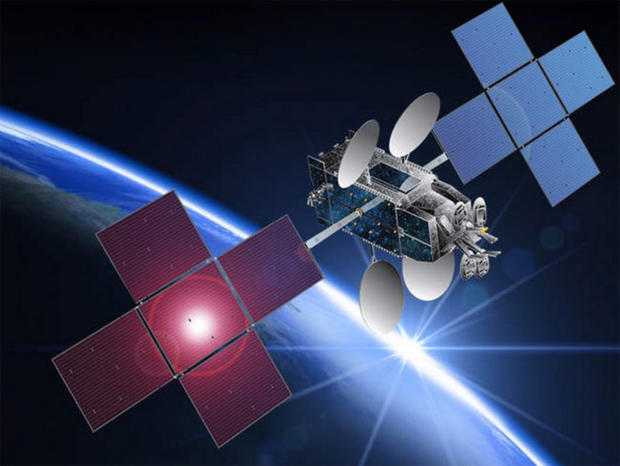EchoStar 19 launched to deliver high-speed internet
A powerful communications satellite was boosted into orbit Sunday by a United Launch Alliance Atlas 5 rocket that will provide broadband internet service to passenger jets and rural consumers across the United States and parts of Canada and Central America that do not have access to cable or fiber networks.
Running 46 minutes late because of a last-second technical snag, the 1.6-million-pound Atlas 5, equipped with three strap-on solid-fuel boosters for extra power, roared to life at 2:13 p.m. EST (GMT-5) and quickly lifted off from launch complex 41 at the Cape Canaveral Air Force Station in Florida, arcing away to the east under a mostly clear sky.
Rapidly accelerating as it consumed its liquid oxygen and kerosene propellants, the 194-foot-tall rocket put on a weekend show for area residents, beachgoers and tourists, leaving a long trail of exhaust in its wake as it climbed out of the dense lower atmosphere and disappeared from view.
The Russian-built RD-180 engine powering the first stage chalked up an apparently flawless performance, handing off to the rocket’s Aerojet Rocketdyne RL10C Centaur second stage engine a little more than four-and-a-half minutes after launch.
As planned, the hydrogen-fueled Centaur engine fired twice and 32 minutes after launch, the 14,914-pound relay station was released from the second stage into a so-called “supersynchronous” orbit with a low point of 127 miles and a high point of around 40,389 miles.
EchoStar 19’s on-board propulsion system will be used to circularize the orbit at an altitude of 22,300 miles above the equator where spacecraft take 24 hours to complete one trip around the planet. In such geosynchronous orbits, satellites appear to hang stationary in the sky, allowing the use of fixed antennas on the ground.
EchoStar operates a fleet of two dozen solely owned, leased and managed relay stations. EchoStar 19, built by Space Systems Loral, will be stationed over North America to provide high-speed broadband internet service from HughesNet, an EchoStar subsidiary that currently serves more than a million customers with two existing satellites -- EchoStar 17 and Spaceway 3.
Along with providing service to rural areas not wired for broadband, EchoStar 19 also will provide 200 megabits-per-second access to passenger jets.
“It’ll provide capacity primarily for our consumer business in the U.S. as well as additional capacity in Canada, Mexico and other countries in Central America,” Pradman Kaul, the president of Hughesnet, told analysts during a recent conference call.
“Subscriber online time and video consumption have continued to increase,” he said in remarks posted by Spaceflight Now. “And today’s subscribers are looking for faster speeds and higher data caps. With HughesNet Gen5, we’ll be offering more data and materially higher speeds than we are today.”
EchoStar 19’s Ka-band antennas will provide 138 spot beams and 22 “gateway” beams covering North America. The satellite has an expected lifetime of 15 years.
“Our target markets will continue to be the geographies not penetrated by cable and fiber, and we believe that the improved service offering will allow us to expand our addressable market of underserved homes,” Kaul said.
“We intend to announce our Gen5 service plans and pricing in January, followed by pre-launch marketing. We are obviously very excited about launching the new Gen5 service on (EchoStar 19).”
The satellite originally was scheduled to launch aboard a European Ariane 5 rocket, but HughesNet wanted to get the spacecraft into orbit earlier -- and generating revenue sooner -- than Arianespace could accommodate. The Ariane 5 typically launches two satellites at a time and a launch slot this year with a compatible second satellite was not available.
The Atlas 5 booster was more expensive than a shared ride aboard the Ariane. Company officials said the added cost was offset by getting the satellite into orbit sooner and because the ULA rocket, carrying a single satellite, could put EchoStar 19 into a supersynchronous orbit that will reduce the propellant needed to reach its operational altitude. That is expected to extend the satellite’s lifetime and revenue stream.
United Launch Alliance is a partnership between Lockheed Martin, original builder of the Atlas family of rockets, and Boeing, which builds the Delta family. ULA launched eight Atlas boosters in 2016 and four Deltas. Sunday’s flight was the 68th overall by an Atlas 5, all of them successful.





